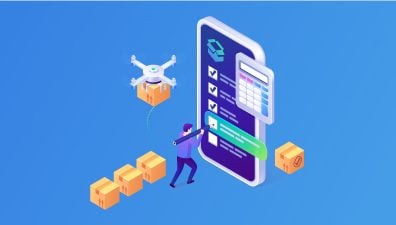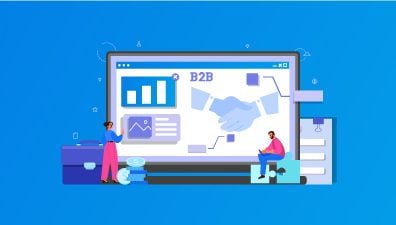In the ever-evolving landscape of eCommerce, one transformative approach that has garnered significant attention is Headless Commerce. This strategy empowers B2C brands to deliver seamless and personalized experiences across digital touchpoints. We comprehensively explore Headless Commerce for B2C brands, including the definition, benefits, considerations, platforms, implementation process, and real-life case studies. Join us as we uncover the remarkable potential of this strategy to elevate customer engagement and drive success in the competitive world of online commerce.
Table of Contents
- Definition of Headless Commerce
- Benefits of Headless Commerce for B2C Brands
- Key Considerations Before Implementing Headless Commerce B2C
- Top 3 Best Headless Commerce B2C Platforms
- Implementing Headless Commerce B2C: Step-by-Step Process
- Real-life Case Studies: Successful Implementation of Headless Commerce for B2C Brands
Definition of Headless Commerce
Headless commerce, often referred to as headless eCommerce, is a contemporary architectural approach within the realm of online retail. In this context, headless eCommerce involves the separation of the front end, which encompasses the visual interface and user experience, from the back end, which comprises the operational logic, product databases, and business processes of an online store.
Unlike conventional eCommerce setups where the front-end and back-end are tightly interconnected, headless eCommerce utilizes APIs (Application Programming Interfaces) to establish a connection between these two components. By doing so, it allows businesses to construct their front-end experiences using contemporary technologies like JavaScript frameworks (e.g., React, Vue.js) in a way that is adaptable to diverse devices and platforms.
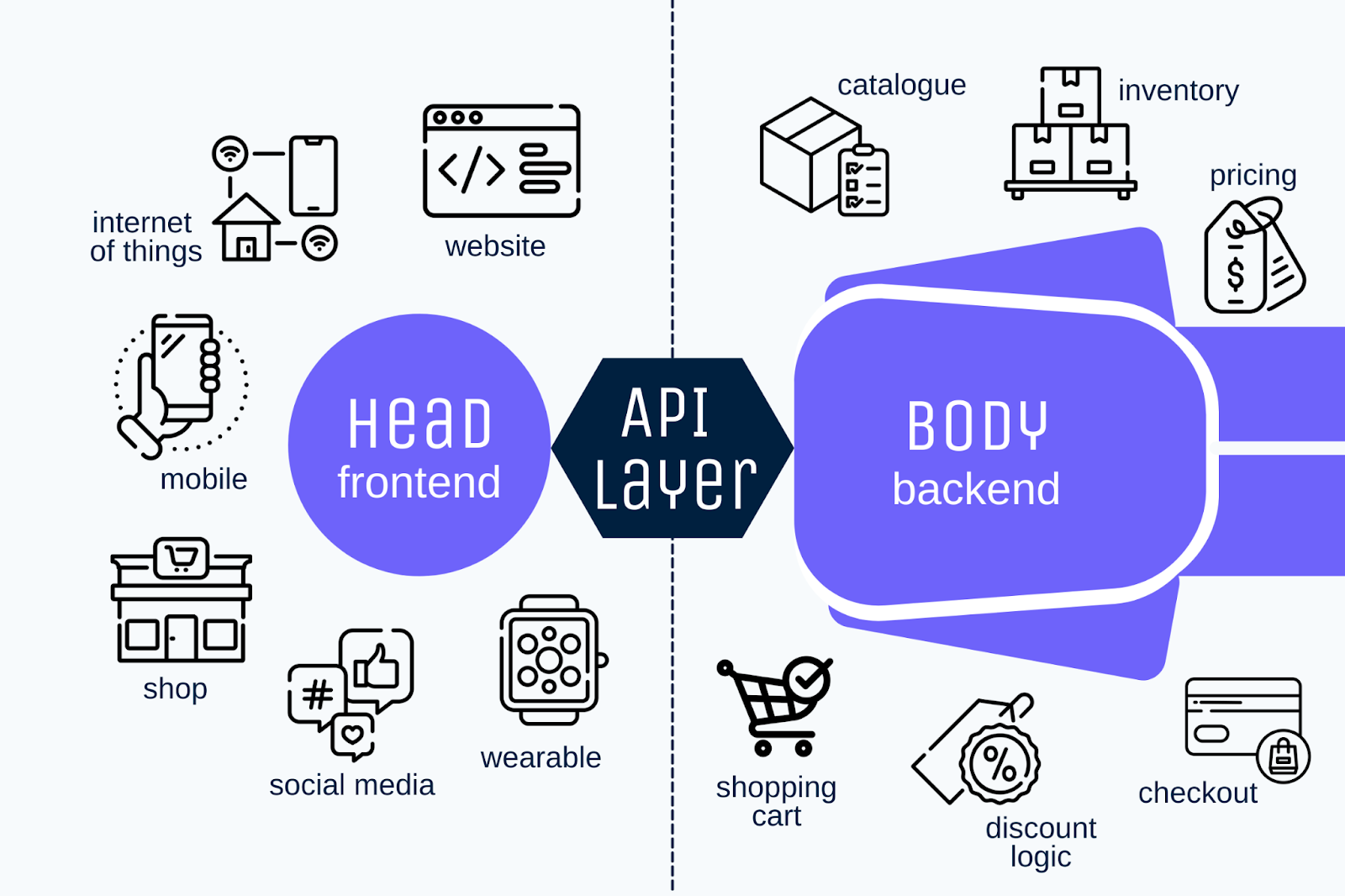
Headless Commerce consists of three main components: the Frontend, Backend, and APIs. Each of these components plays a crucial role in the overall architecture and functioning of a Headless Commerce system.
- Front-End: The front end is the user-facing part of the eCommerce platform. It encompasses the visual design, user interface (UI), and user experience (UX) elements that shoppers interact with. The front end is responsible for displaying products, allowing users to browse and search for items, adding products to their cart, and completing the checkout process. In a Headless Commerce setup, the front end is decoupled from the backend, allowing for independent updates and customization. It can be built using various technologies, such as JavaScript frameworks like React, Angular, or Vue.js.
- Back-end: The back end is the core operational component of the eCommerce platform. It includes the database, business logic, and services that manage products, inventory, orders, payments, user accounts, and other essential functions. In a Headless Commerce architecture, the backend is also decoupled from the front end. It exposes APIs that the front end can use to fetch and send data. The backend handles complex operations, processes transactions, and manages the overall business logic of the eCommerce platform.
- APIs (Application Programming Interfaces): APIs act as the communication bridge between the frontend and backend components. They define a set of rules and protocols that allow different software systems to interact with each other. In a Headless Commerce model, the backend exposes APIs that the frontend uses to request data (e.g., product information, user data) and send data (e.g., new orders, user interactions). APIs enable seamless data exchange and synchronization between the two components. They can be implemented using RESTful APIs or GraphQL, among other technologies.
Benefits of Headless Commerce for B2C Brands
Improved Agility and Flexibility
Headless commerce presents a range of benefits for B2C eCommerce brands, particularly in terms of agility and flexibility. This approach allows brands to rapidly adjust their front-end experiences in response to changing market trends and evolving customer preferences. Unlike traditional monolithic eCommerce setups, where making alterations to the user interface could be intricate and time-consuming, headless commerce empowers B2C brands to swiftly tailor their front-end experiences to capture current trends and align with customer desires.
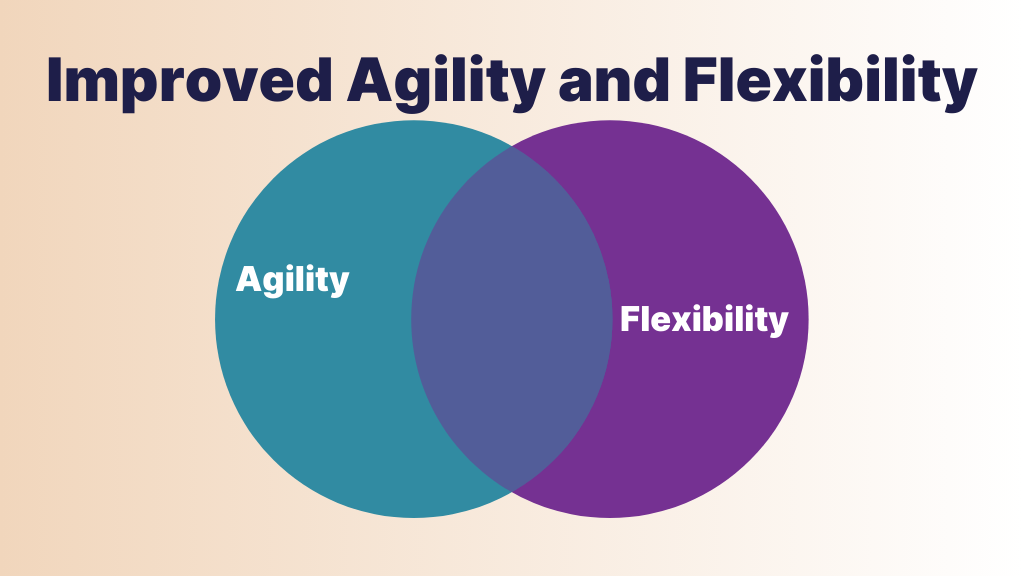
Moreover, the agility of headless commerce B2C shines through in the rapid introduction of new features and enhancements. Unlike the conventional approach where altering the user interface might entail complex adjustments in the back-end system, the decoupled nature of headless architecture enables the independent development of both front-end and back-end components.
This separation facilitates the quick implementation of novel features and improvements to the online platform without disrupting core commerce operations. This agility empowers brands to respond promptly to user feedback, introduce innovative functionalities, and maintain a competitive edge in the fast-paced eCommerce landscape.
Furthermore, the headless eCommerce model ensures that B2C brands are well-prepared to stay abreast of emerging technologies and evolving user experience trends. By concentrating updates primarily on the front-end layer, brands can seamlessly integrate new technologies, design approaches, and interactive elements into their user interfaces.
This ensures that their online presence remains aligned with the latest industry standards and user expectations. Brands that embrace headless commerce B2C can future-proof their digital offerings, sustaining a dynamic and engaging online presence that consistently resonates with their target audience.
Enhanced Customer Experience
Headless commerce B2C offers brands a plethora of benefits that culminate in an enhanced customer experience, a critical factor for success in today’s competitive digital landscape.
One of the standout advantages is the ability to provide consistent omnichannel shopping experiences across a diverse range of devices and platforms. Unlike the limitations of traditional eCommerce setups, where adapting the user interface for different devices might result in inconsistencies. Headless commerce B2C allows brands to seamlessly deliver a cohesive shopping journey regardless of whether customers are on a desktop, mobile device, or other platforms. This seamless transition between channels ensures that customers can interact with the brand consistently, fostering brand loyalty and satisfaction.
Moreover, headless commerce enables B2C brands to offer tailored experiences that resonate deeply with individual customers. Through advanced personalization techniques and rigorous A/B testing, brands can customize the user journey to match each customer’s preferences and behaviors. This personal touch not only enhances engagement but also increases the likelihood of conversions, as customers are more likely to resonate with content and offers that are relevant to their needs and desires.

The integration of third-party tools and services directly into the front-end experience represents yet another dimension of enhanced customer engagement. By seamlessly incorporating functionalities such as social media integration, real-time chat support, or interactive product visualization, brands can enrich the overall user experience. This added functionality not only provides convenience but also encourages customers to spend more time on the platform, thereby increasing the potential for conversions and sales.
Efficient content management and delivery are also elevated through headless commerce, thanks to Content Management Systems (CMS) platforms. Brands can manage and deliver content across various channels with ease, ensuring that information is consistent, accurate, and up-to-date. This consistency contributes to a seamless customer experience, as customers encounter the same information and branding across different touchpoints, reinforcing brand identity and fostering trust.
Performance and Scalability
The performance and scalability advantages offered by headless commerce are paramount for B2C eCommerce brands seeking to provide a seamless and responsive online shopping experience to their customers.
Firstly, headless commerce B2C architecture allows for improved website and application performance by enabling the independent optimization of both front-end and back-end components. In traditional monolithic systems, any adjustments or optimizations made to one part of the system might inadvertently impact other components, leading to performance bottlenecks or inefficiencies.
In a headless setup, these components are decoupled, meaning that developers can fine-tune and optimize each part individually. This results in faster loading times, smoother interactions, and an overall more satisfying user experience for customers navigating the online store.
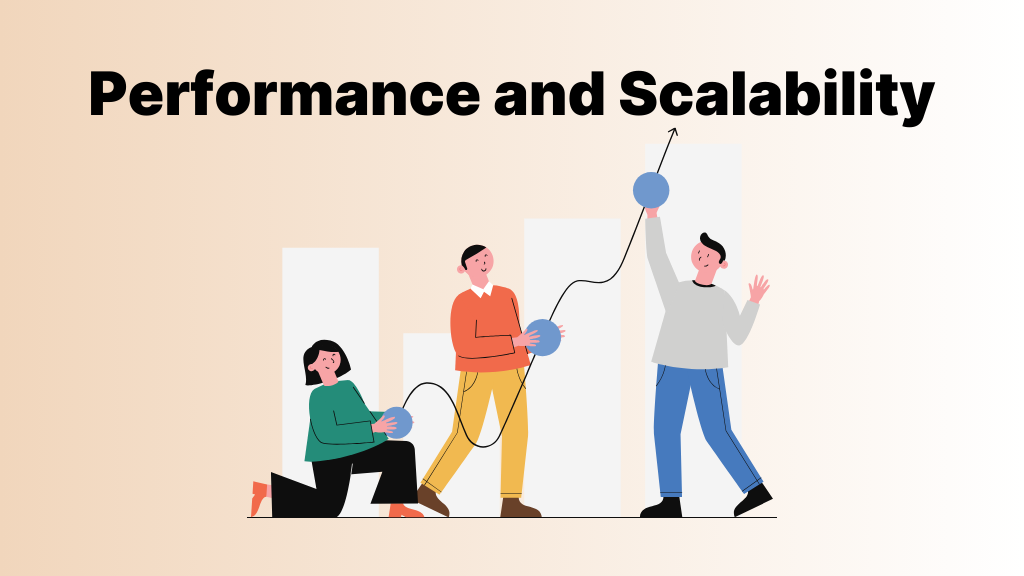
Secondly, the scalability of headless commerce B2C extends to both front-end and back-end resources, providing brands with the ability to handle increased user demands without compromising performance. As the popularity of an eCommerce platform grows and user traffic spikes, traditional systems might struggle to accommodate the influx of visitors, potentially leading to slow response times or crashes.
However, with headless architecture, front-end resources can be scaled independently of the back-end infrastructure. This means that during peak times, the front end can handle higher traffic loads by dynamically allocating additional resources, ensuring a consistently smooth experience for customers regardless of the number of concurrent users.
Global Reach and Localization
The global reach and localization advantages of headless commerce play a pivotal role in helping B2C eCommerce brands extend their presence across diverse markets and effectively engage with customers from various regions.
Headless commerce B2C provides the capability to cater to distinct regional preferences and languages through front-end-level localization adjustments. Unlike traditional eCommerce setups, where implementing changes for different regions could be complex and time-consuming, headless architecture simplifies the process. Brands can modify and adapt the user interface, content, and even functionalities to align with the cultural nuances and preferences of specific geographic areas.

For instance, brands can seamlessly incorporate region-specific language options, currency formats, and localized content on their websites or applications, ensuring that customers from different parts of the world have a tailored experience that resonates with their preferences. This localized approach goes beyond mere translation, enabling brands to create authentic and relevant interactions that make customers feel understood and valued.
Furthermore, headless commerce’s capacity for front-end level localization adjustments fosters a consistent brand identity while respecting regional differences. This consistency is critical for maintaining brand recognition and customer trust, even as the shopping experience is fine-tuned to suit local tastes and needs.
Key Considerations Before Implementing Headless Commerce B2C
Implementing headless commerce B2C requires a thorough consideration of several key factors to ensure a successful and effective transition. These considerations can help B2C brands make informed decisions that align with their strategic goals and set the stage for seamless adoption of this innovative architecture.
- Business Goals and Objectives: First and foremost, aligning the decision to go headless with the business’s overarching goals and objectives is crucial. Evaluate how a headless approach will support your brand’s growth strategies, enhance customer engagement, and contribute to revenue generation. Understanding the alignment between headless commerce and your business objectives will provide a clear roadmap for implementation.
- Technical Expertise and Resources: Technical expertise and available resources should also be carefully assessed. It’s important to gauge whether your existing team possesses the necessary skills to manage the complexities of a headless architecture. If there are gaps in technical capabilities, consider whether to hire additional talent or collaborate with experts who have experience in headless development.
- Integration with Existing Systems: Integration with existing systems is another pivotal consideration. Evaluate how seamlessly your current systems and third-party integrations can transition into a headless setup. Ensure that APIs are robust and well-supported, as smooth integration is essential for maintaining operational efficiency.
- Scalability and Performance: Scalability and performance are vital aspects to address. Assess the scalability requirements of your business to accommodate future growth and traffic fluctuations. Consider how headless architecture can enhance performance and user experience, particularly during peak usage periods.
- User Experience and Design: User experience (UX) and design should not be overlooked. The decoupling of the front end can impact the overall user journey and design consistency. Strategize how to maintain a cohesive brand identity and seamless user experience across diverse devices and channels.
Top 3 Best Headless Commerce B2C Platforms
Adobe Commerce
Formerly known as Magento Commerce, Adobe Commerce emerges as a formidable headless commerce platform catering to both B2C and B2B merchants. Operating on an API-based architecture, it leverages GraphQL for seamless data transfer, enabling businesses to craft personalized and captivating customer experiences. This flexibility extends to the incorporation of third-party extensions, user-generated extensions, and the robust inherent capabilities of Adobe Commerce.
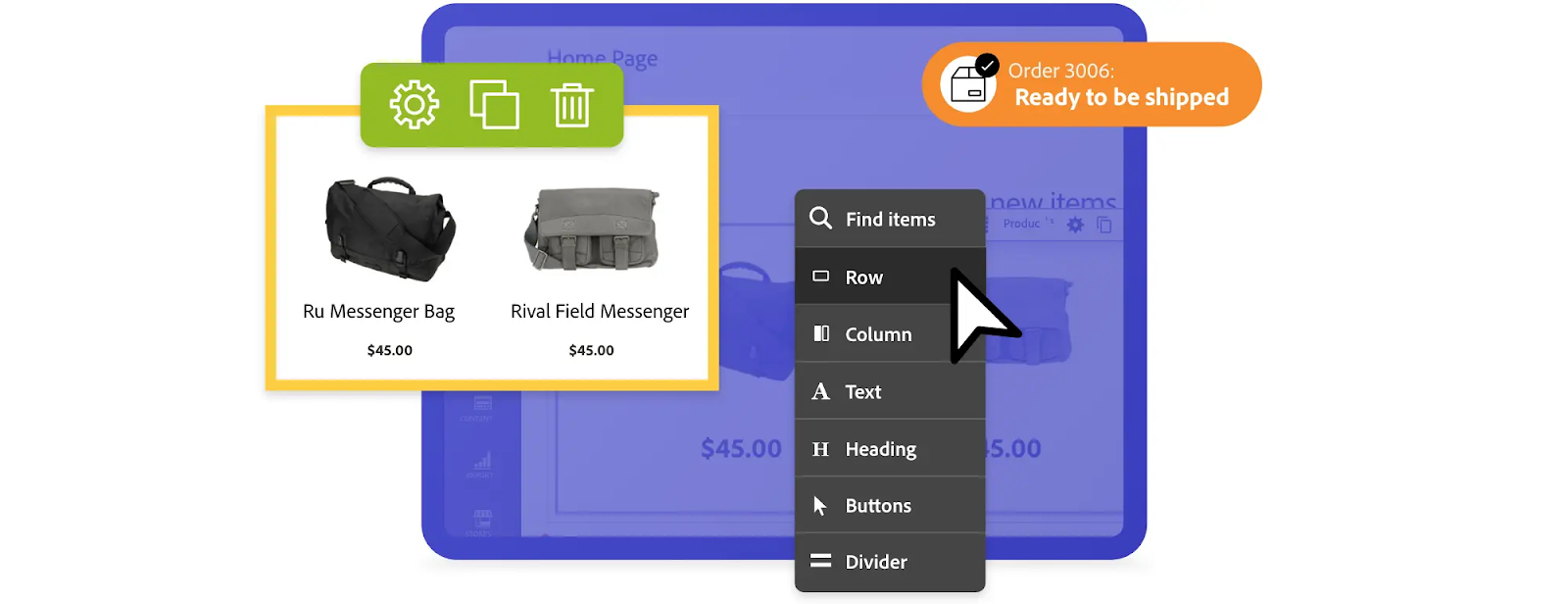
Distinguished by its headless digital commerce prowess, Adobe Commerce aligns effectively with Adobe Experience Manager and seamlessly integrates with PWA Studio for website design. The platform expedites time-to-market during implementation and proves especially suitable for organizations navigating multifaceted sales models and diverse customer touchpoints.
While excelling in the realm of headless commerce B2C, Adobe Commerce doesn’t prioritize extensive analytics, marketing automation, or content management functions. This is due to Adobe’s complementary suite of products, including Experience Manager, Adobe Analytics, and Adobe Marketo Engage, which address these specific niches. Collectively, these offerings synergize to elevate business operations to unparalleled heights.
Shopify
Shopify’s prominent position in eCommerce has been amplified by its evolution into Headless Commerce through Shopify Plus. This platform introduces modernity by harnessing the GraphQL API, enabling seamless multi-channel commerce while maintaining its reputation for stability. With creative control over diverse touchpoints, businesses can integrate essential systems, including CRM, PIM, CMS, and ERP, and connect with major services like Google Sheets and Amazon. Its intuitive user interface and robust customer support further enhance its appeal.
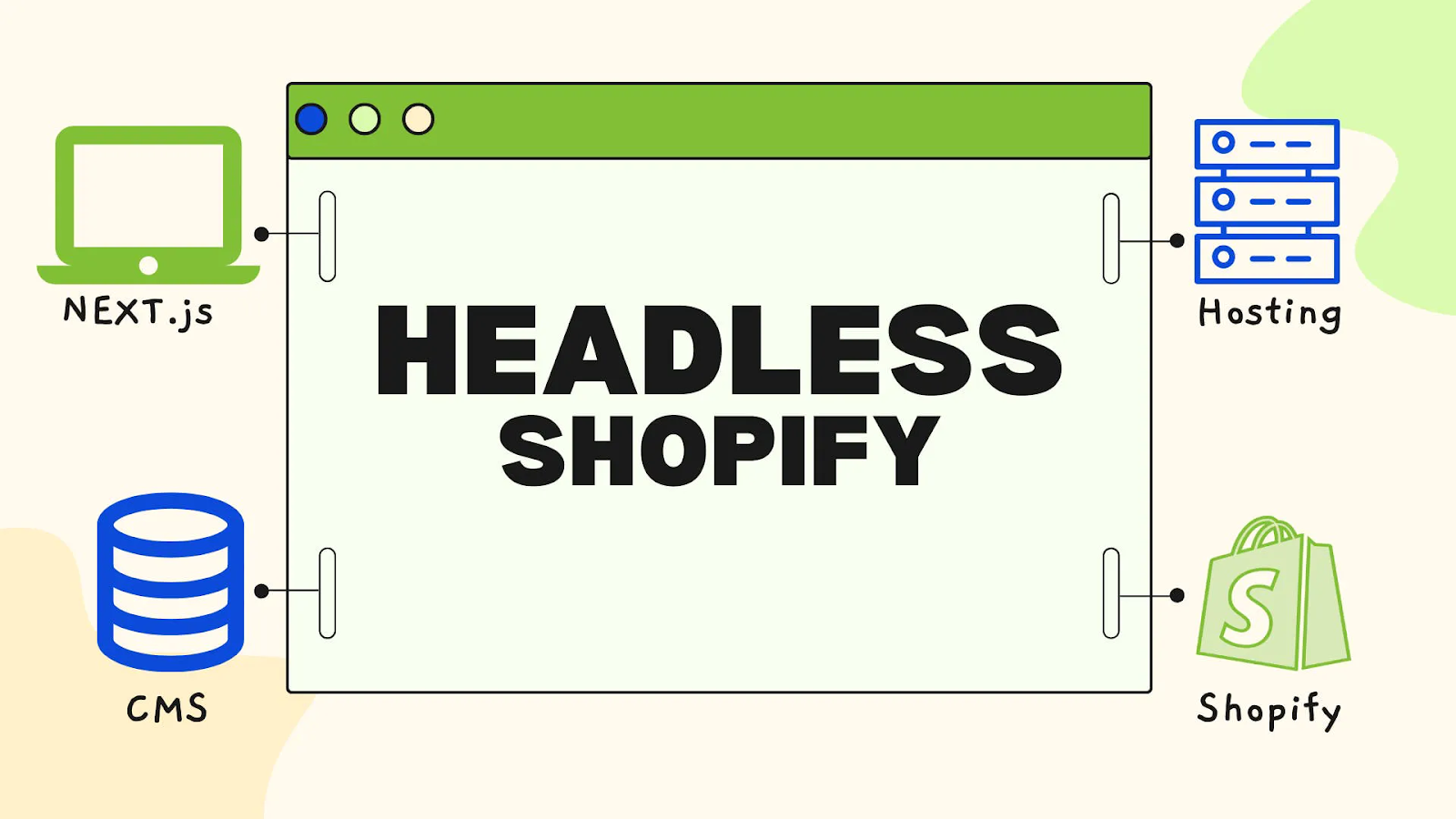
Shopify Plus, tailored for enterprises, embraces headless architecture and empowers extensive customization. While celebrated for reliability and scalability, some limitations exist in backend customization and advanced tools. Regardless, Shopify Plus offers a powerful choice in the Headless Commerce B2C landscape, with its legacy and adaptability making it a compelling solution for B2C businesses aiming to establish a solid, tailored eCommerce foundation.
BigCommerce
BigCommerce emerges as a dynamic headless commerce B2C platform catering to brands seeking tailored online stores. This SaaS provider effectively serves midsize to larger businesses with its scalable infrastructure and extensive API offerings for swift commerce feature adoption. Boasting a plethora of robust features such as single-page checkout, multicurrency support, and user-friendly sales tools, BigCommerce excels as a versatile multichannel selling solution, enabling brands to effectively engage audiences across social media and other touchpoints.
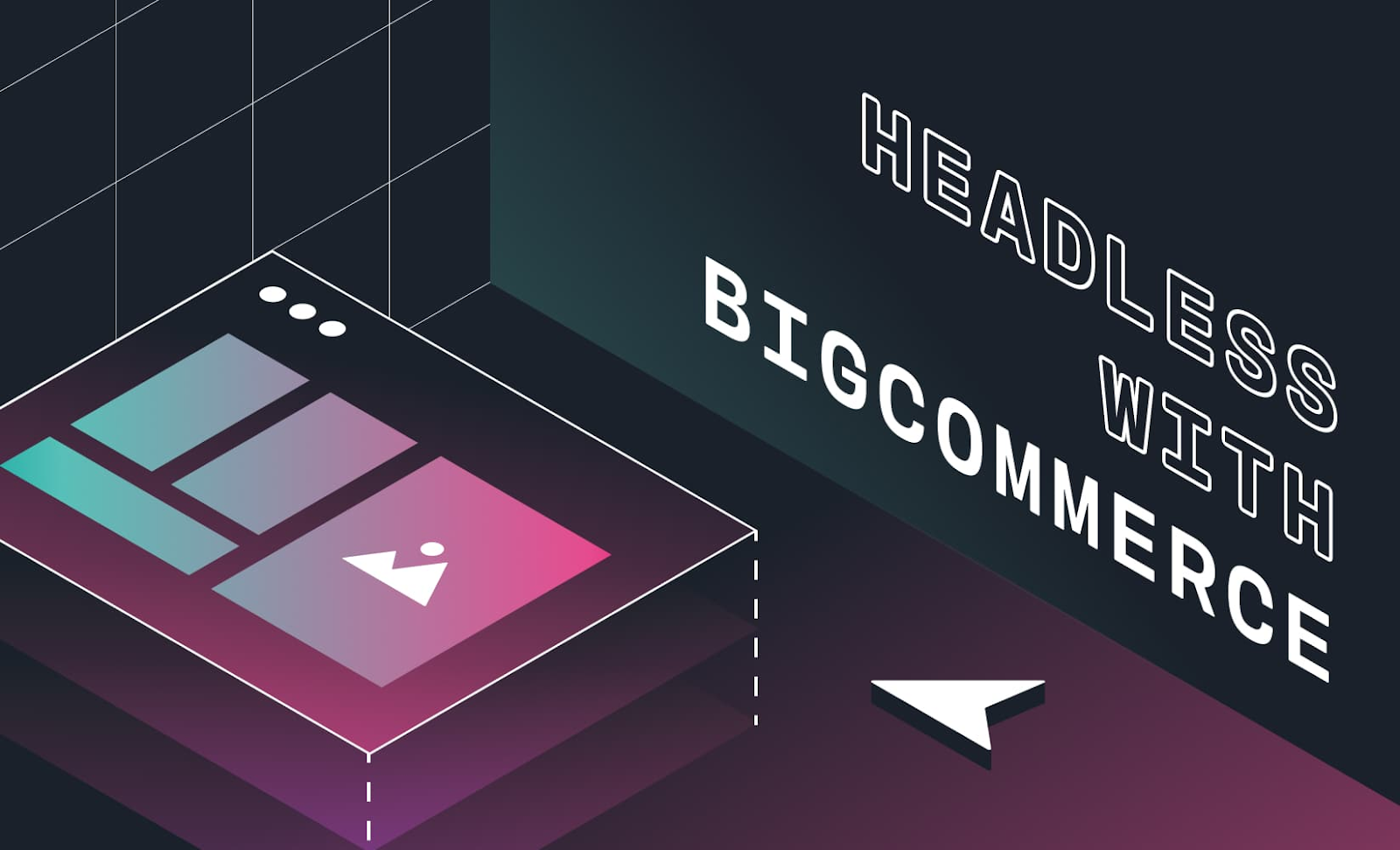
Nonetheless, despite its merits, BigCommerce does exhibit a few limitations. Its tiered subscription model could be considered restrictive, automatically upgrading plans based on annual sales volume. The platform’s advanced features may require a steep learning curve, as their intuitiveness is not consistent across all tools.
BigCommerce stands out as a prominent player in the headless commerce B2C space, offering enterprise-level functionality, performance, and an impressive app-based system. It caters to both B2B and B2C sectors, providing scalability for businesses aiming to expand at their desired pace. The platform supports API-driven experiences through integrations and APIs, including popular services like WordPress, eBay, Google, Stripe, and more. With its compatibility with WordPress and a lack of API call throttling, BigCommerce offers a one-month free trial and affordable plans.
Implementing Headless Commerce B2C: Step-by-Step Process
Step 1: Selecting a Headless Commerce B2C Solutions
The foundational step revolves around selecting a suitable Headless Commerce solution that aligns with your brand’s vision and business objectives. Evaluate various solutions in the market, considering factors such as scalability, flexibility, API capabilities, and the potential for future growth. Make an informed decision that caters to the unique demands of your B2C operation and lays the groundwork for a successful implementation.
Step 2: Choosing a Content Management System (CMS)
A pivotal aspect of the process involves selecting an appropriate Content Management System that seamlessly integrates with your chosen Headless Commerce solution. Your CMS should empower your team to manage and curate engaging content for the front-end user experience. Consider the CMS’s flexibility, customization options, and ease of use to ensure that you can deliver captivating digital experiences to your B2C audience.
Step 3: Developing Front-End Experiences
The heart of Headless Commerce B2C lies in crafting compelling front-end experiences that resonate with your target audience. Utilize modern frontend technologies, such as React, Angular, or Vue.js, to design intuitive and responsive user interfaces. Implement visually appealing designs, interactive elements, and seamless navigation that enhance user journeys and encourage meaningful engagement.
Step 4: Integrating Backend and APIs
Creating a seamless connection between the front end and back end is essential for delivering a unified user experience. Develop robust APIs that facilitate data exchange between the two components, enabling critical eCommerce functionalities such as order processing, inventory management, and payment handling. Focus on security, documentation, and efficiency to ensure smooth communication and seamless transaction flows.
Step 5: Customization and Personalization
Leverage the potential of Headless Commerce B2C to customize and personalize user interactions. Tailor your offerings based on customer preferences, behaviors, and purchase history. Implement dynamic product recommendations, personalized content, and targeted marketing campaigns that resonate with individual users. Utilize data insights to create memorable and impactful experiences that foster brand loyalty.
Step 6: Performance Optimization
Optimizing performance is a continuous effort that directly impacts user satisfaction and conversion rates. Implement performance optimization strategies such as caching, content delivery networks (CDNs), and image compression to enhance site speed and responsiveness. Regularly monitor performance metrics, identify bottlenecks, and refine your approach to ensure a seamless and efficient user experience.
While the outlined step-by-step process provides a solid framework for implementing Headless Commerce B2C, it’s important to recognize that every business is unique, and flexibility is key. Adapting the process to specific needs, seeking advice from experts, and considering industry best practices can lead to even more tailored and successful implementations. You can check out the below case studies to further understand the nature of Headless Commerce B2C.
Real-life Case Studies: Successful Implementation of Headless Commerce for B2C Brands
SM Markets
One remarkable example of a successful implementation of Headless Commerce for B2C brands is the case of SM Markets. As a brand owned by SM Investments Corporation, a multi-industry Filipino corporation, SM Markets embarked on an ambitious journey to enhance its online retail presence and elevate customer experiences. Faced with the challenge of modernizing their outdated eCommerce website and meeting growing customer expectations, SM Markets sought the expertise of Magenest, an Adobe partner. Their primary goal was to enrich the customer experience, boost performance, and ensure reliability across the eCommerce system.
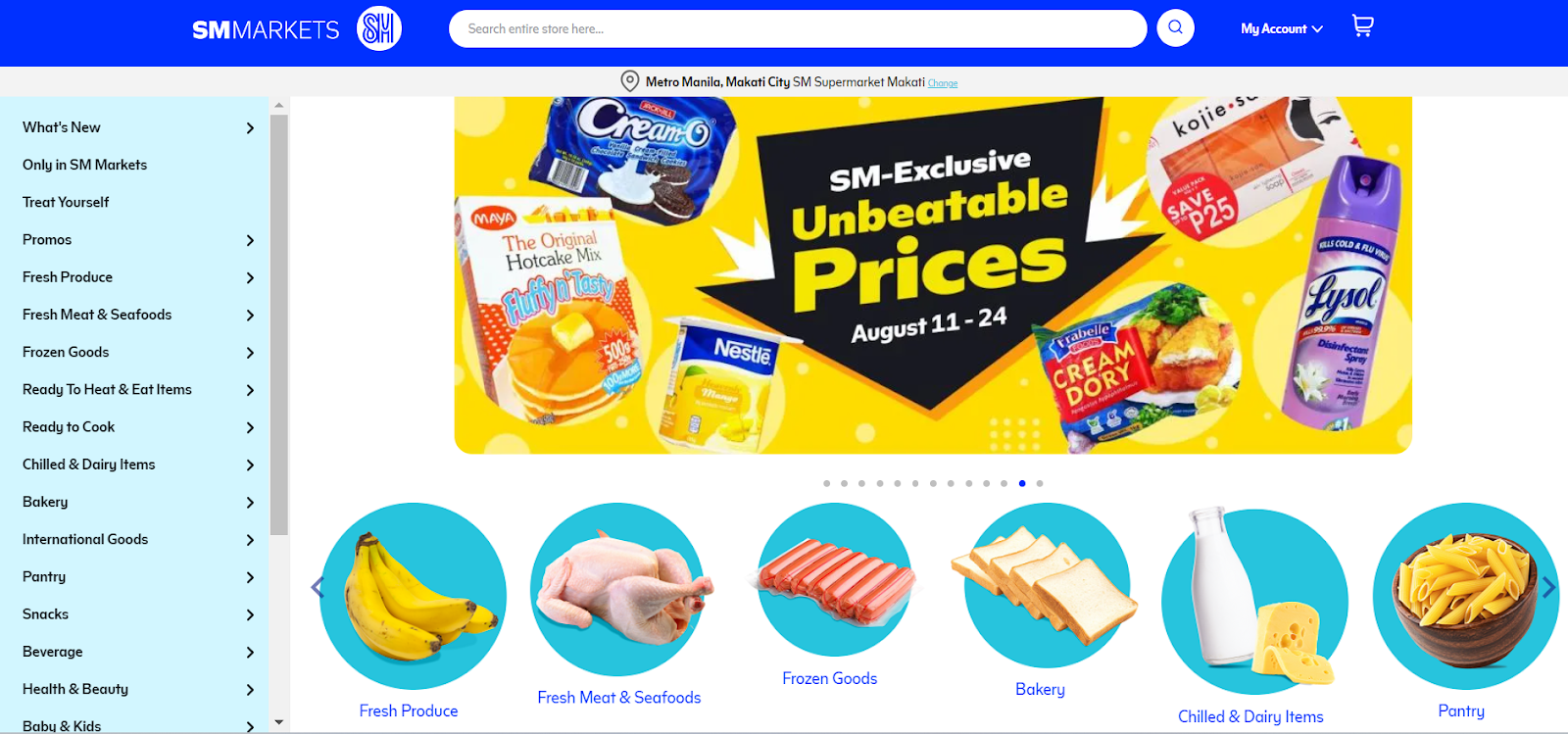
Magenest’s solution encompassed various critical aspects. Firstly, Magenest refactored SM Markets’ existing Magento 2 system, eliminating bugs and upgrading the code to Magento’s standards. This optimization led to a significantly improved user experience on the website.
Secondly, by recognizing the power and ubiquity of smartphones, Magenest developed a custom mobile app for SM Markets. This app empowered supermarket managers to efficiently manage orders and stock availability, enhancing operational precision and speed.
Furthermore, along with affiliate pickup enhancement, which helps to tackle the challenge of order fulfillment efficiency, Magenest integrated an AI-powered chatbot. This helps to elevate customer engagement, supporting tasks such as account creation, product inquiries, product recommendations, and order tracking.
Finally, to meet the demand for a seamless customer experience, Magenest designed a new user interface (UI) specialized for grocery shopping. This UI was optimized for Progressive Web Apps (PWA) across PC and mobile devices, unifying the shopping experience and bolstering an omnichannel approach.
The result of this comprehensive transformation was nothing short of spectacular. SM Markets witnessed substantial improvements in their eCommerce framework’s performance, customer experience, and order fulfillment efficiency. The implementation’s success translated into increased order numbers and revenue for the brand, solidifying the platform’s position as a top-of-mind shopping destination for Filipinos.
This case study exemplifies how a well-executed Headless Commerce B2C strategy, combined with expert partner collaboration, can lead to remarkable enhancements in both online retail performance and customer satisfaction.
K2 Sports
K2 Sports, a conglomerate of renowned global outdoor brands, embarked on a triumphant Headless Commerce implementation, exemplifying the potential for B2C success in this domain. Facing challenges with their former Salesforce Commerce Cloud platform, K2 Sports found themselves restricted in delivering cutting-edge shopping experiences due to the lack of APIs. Moreover, the platform’s non-SaaS nature resulted in escalating costs and hindered international expansion. To overcome these obstacles and seek a more cost-effective and marketer-friendly solution, K2 Sports turned to Headless Commerce.
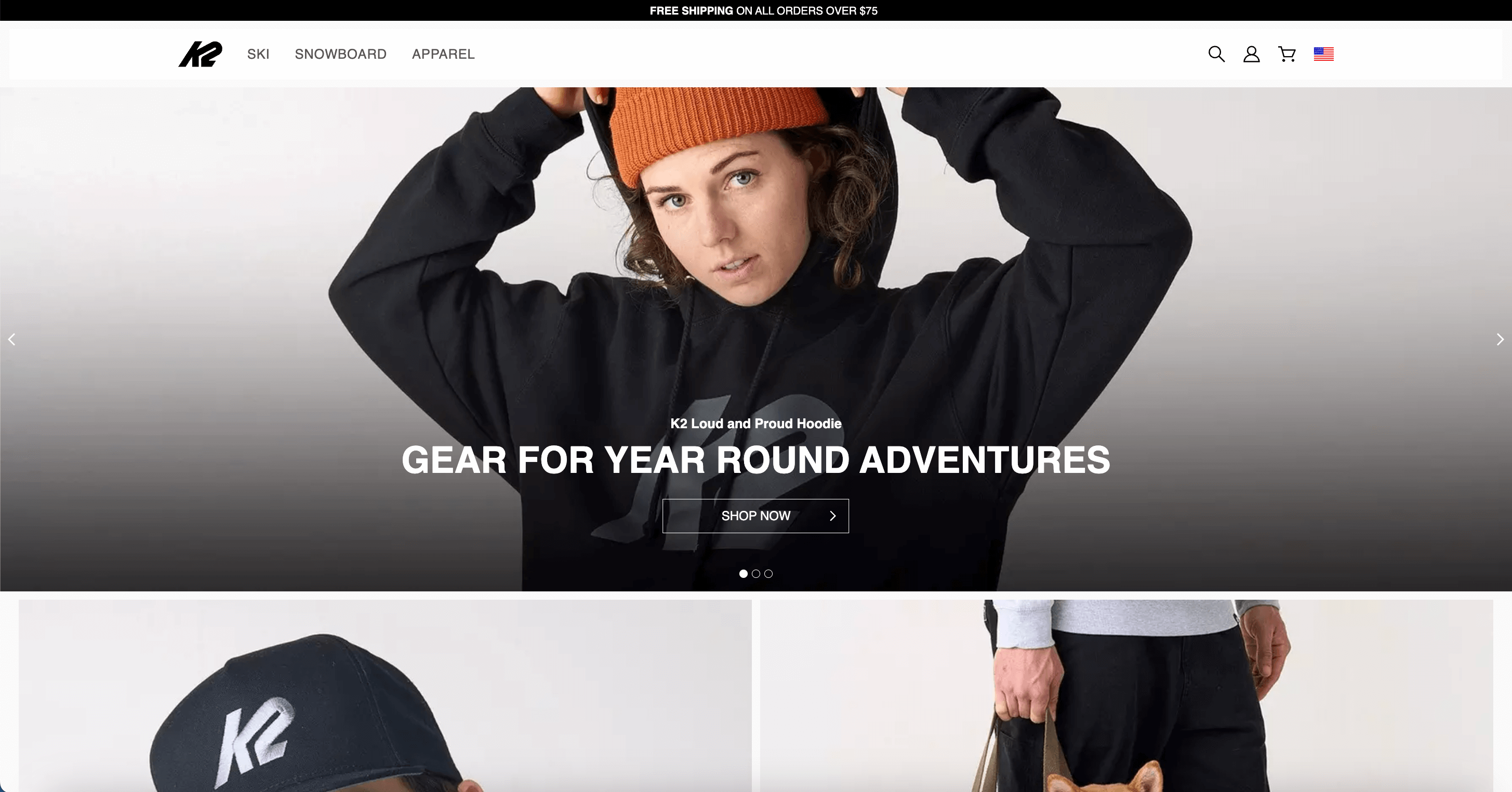
Opting for a headless configuration, K2 migrated from their monolithic platform to a SaaS-backed solution.
- Improved Performance: BigCommerce’s robust backend provided K2 with enhanced API performance and speed, enabling innovative shopping experiences for their customers.
- Cost Savings: By migrating to a SaaS-backed solution with BigCommerce as the backend, K2 minimized ownership costs, contributing to better financial efficiency.
- Tailored Content Experiences: K2 leveraged Contentstack as their frontend CMS, allowing them to create content-rich experiences tailored to diverse audiences, enhancing user engagement.
- Rapid Brand and Site Expansion: With the headless setup, K2 successfully launched eight brands and sixteen sites in just nine months, showcasing the scalability of BigCommerce.
- Efficient Content Creation: Contentstack accelerated content publishing, reducing development dependencies and streamlining site development by 75%.
- Speedy Content Publication: K2 achieved a 90% increase in content publication speed, ensuring that new content reached their audience faster.
- Enhanced Productivity: Overall productivity at K2 improved by an impressive 50%, as evidenced by a case study conducted with Contentstack, highlighting the efficiency gains from using BigCommerce as the backend.
This compelling case study underscores how K2 Sports leveraged Headless Commerce B2C to surmount challenges, accelerate innovation, and heighten operational efficiency. Their successful journey serves as a testament to the potential of Headless Commerce in enabling B2C brands to achieve enhanced agility, superior content delivery, and rapid expansion.
Burrow
Burrow, a pioneering direct-to-consumer furniture store, embarked on a triumphant journey within the realm of Headless Commerce B2C. Founded to redefine furniture shopping, Burrow introduced stylish and modular products, resonating with customers and amassing $3 million in sales within a short span since its 2017 inception. This rapid success, while promising, highlighted the imperative for an eCommerce platform that could seamlessly accommodate their growth trajectory. As Burrow’s trajectory accelerated, they encountered challenges necessitating a robust and scalable backend system. Their agile marketing strategy demanded swift and seamless site customization, enabling constant testing and optimization for their audience. The pursuit was a platform that would liberate creativity from template constraints and empower non-developers to effect simple changes autonomously.
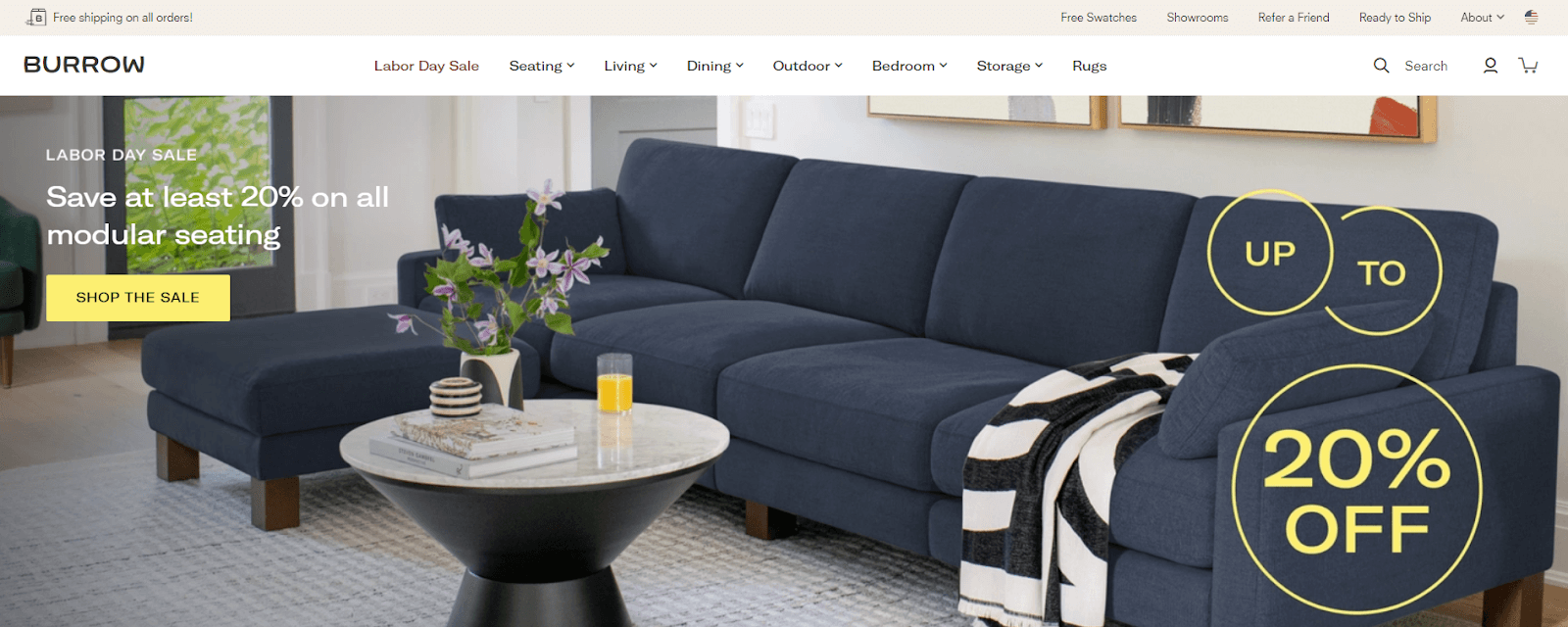
Burrow’s solution materialized with BigCommerce as the backbone, aligning perfectly with their needs. Kabeer Chopra, Co-Founder and CPO of Burrow illuminated the profound impact of being headless, fueling platform modernization and facilitating outstanding digital experiences across diverse channels. Here is what Burrow benefits from when using BigCommerce as a headless commerce B2C platform
- Operational Efficiency: BigCommerce’s scalable backend solution allowed Burrow to streamline its operations, freeing up resources for marketing-focused improvements.
- Customized Customer Experiences: With a custom CMS on the front end, Burrow was able to create tailored customer experiences that went beyond the limitations of templates.
- Flexibility and Innovation: BigCommerce accommodated the complexities of Burrow’s modular product line, providing the freedom to customize and innovate.
- Headless Commerce Success: Embracing a headless commerce approach for B2C sales resulted in a remarkable 30% increase in conversion rates within just two months.
- Improved Site Performance: Burrow experienced a substantial 50% acceleration in site speed and overall performance, enhancing user satisfaction.
- Creative Empowerment: The headless approach empowered Burrow to be more creative in its digital strategy, fueling platform modernization and enabling exceptional digital experiences across various channels.
Burrow’s narrative encapsulates the transformative prowess of Headless Commerce B2C. By aligning with the headless paradigm using BigCommerce, Burrow not only navigated challenges but also achieved remarkable growth, innovation, and an elevated customer experience. This compelling example underscores the potential of a well-executed Headless Commerce strategy in steering B2C brands toward unprecedented success.
In conclusion
The journey into Headless Commerce for B2C brands is an expedition into the future of online commerce. With the power to customize, personalize, and engage like never before, this strategy offers a pathway to unparalleled success. By understanding the intricacies, benefits, and implementation intricacies, B2C brands can harness the full potential of Headless Commerce to captivate audiences, drive conversions, and secure their place at the forefront of digital innovation.
If you need any help in the progress of implementing headless commerce b2c, feel free to contact us!


